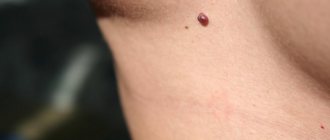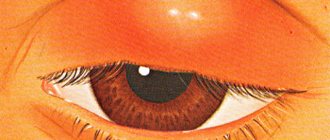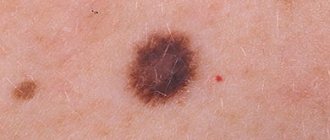What to do if you cut a mole while shaving?
Moles are located on any part of the body and are often subject to mechanical damage. The formation is especially often injured during shaving. If a nevus is damaged during depilation, you must be able to provide first aid. Such a problem cannot be ignored, otherwise the mole may fester or degenerate into melanoma - a malignant tumor.
How to stop bleeding?
If a mole was accidentally cut off while shaving, the first step is to stop the bleeding. To do this, follow a few simple steps:
- Treat the damaged area with hydrogen peroxide.
- Apply a piece of cotton wool or bandage, pressing it against the damaged mole for 10-15 minutes.
- If the nevus was damaged in the intimate area, then a bandage soaked in peroxide should be applied to the bleeding formation and left for 15 minutes.
- In case of prolonged and severe bleeding caused by damage to the angioma, it is necessary to apply a gauze bandage.
Stopping bleeding should be done immediately after the cut. This will help to quickly stop the blood without affecting its clotting process.
How to treat the damaged area?
After the bleeding has been stopped, the wound must be disinfected using any antiseptic to prevent infection and stop the inflammatory process. You can treat the damaged area with brilliant green, iodine solution or antibacterial ointment (Levomycetin, Ichthyol). If the injury occurred in the intimate area, then you can use a solution of Chlorhexidine or Miramistin. These medications are effective, safe and inexpensive antiseptics that are gentle on the skin. You can also treat a cut with a special alum stone, which is widely used in cosmetology and medicine.
What to do next?
After treatment of the wound is completed, it is necessary to bandage the damaged area of the body, reducing the risk of re-injury. If the cut is not severe, then these actions will be enough to provide first aid. If the nevus is severely damaged, it is recommended to immediately consult a dermatologist. If a person completely cuts off a mole while shaving, then a piece of tissue should be saved and submitted for histological analysis in order to identify the nature of the neoplasm.
Even with a minor injury, it is best to visit a medical facility to eliminate the possibility of complications.
Is it possible to tear off a mole completely?
It often happens that during shaving, a mole is cut off at the base, but not all the way. In this case, the nevus hangs and gets in the way. Then many people decide to tear off the mole completely or remove the remaining part using traditional methods. Doing this is strictly prohibited, as it can seriously aggravate the situation. If the mole does not come off completely, then you need to consult a doctor who will perform the procedure of excision in the correct medical way. Removal of formation can occur in the following ways:
- exposure to liquid nitrogen;
- laser removal;
- exposure to electric current or radio waves;
- excision with a scalpel.
Timely removal of a mole allows you to avoid its malignancy, but such an operation can only be carried out in extreme cases with the permission of a doctor.
What does melanoma look like?
As noted above, in the early stages, a deadly tumor may look like an ordinary “mole” and may not attract the attention of people without medical education. However, there are signs of melanoma that everyone can and should remember. Dermato-oncologist Dmitry Beinusov told MUEHLE Russia readers about these signs.
Dmitry Beinusov
Reference: Dmitry Sergeevich Beinusov, Candidate of Medical Sciences, dermato-oncologist, member of the European Society of Surgical Oncology. Works in St. Petersburg.
People without medical education call completely different formations moles. Some of them are harmless, some are potentially dangerous. Unfortunately, people can mistake a “mole” for a deadly tumor: melanoma. The question is: can an ordinary person, without consulting a specialist, find out exactly what formations are on his face, and whether they pose a danger?
To easily determine the potential danger of a mole, there is the acronym ACCORD (analogous to the English ABCDE):
- A - asymmetry - it is impossible to draw an axis of symmetry through a mole.
- K - the edge has become jagged or scalloped.
- K - bleeding of a mole without external influence.
- O - the color has become uneven, black, red or white has appeared.
- P - the size has increased and become more than 6 mm.
- D - dynamics - hair loss from the mole, disappearance of the skin pattern, persistent redness, the appearance of a glossy sheen or dry crusts.
If your mole meets at least one of these points, it is worth showing it to a dermato-oncologist. Unfortunately, even knowledge of this rule cannot reduce to zero the risk of missing melanoma. Because of this, I recommend that all people undergo a complete examination of all moles on their skin by a specialist at least once a year.
Visualization of signs of melanoma: photo from Toowong Dermatology website
People are afraid of moles because many have heard about melanoma. Is it true that this tumor can also develop on skin areas without moles?
According to one large study from 2022, melanoma develops against the background of unchanged skin in 70% of cases. In the remaining 30%, the tumor develops against the background of moles.
Is it true that a deadly melanoma tumor can look atypical, not like a mole? And I also heard that there are other potentially dangerous tumors on the face, which most people do not pay attention to at least in the first stages of development?
Yes this is true. However, you should not fall into paranoia on this basis. These tumors can also pretend to correspond to one of the points of the ACCORD rule (see above).
Follow-up
After first aid has been provided, it is necessary to carefully monitor the condition of the nevus and consult a doctor if there is the slightest change in the formation.
What to do if a mole bleeds?
If a mole is located near large capillaries, then damage to it can lead to severe bleeding. The first step is to try to stop the bleeding on your own using a sterile bandage treated with hydrogen peroxide or ammonia. If the bleeding does not stop, then you need to seek help from a medical facility.
When should you see a doctor?
If you damage a mole while shaving, it is not necessary to immediately go to the doctor. But you should not hesitate to visit a specialist if the following changes are observed:
- blood periodically appears at the site of injury;
- the shape of the nevus has changed, its edges have become asymmetrical;
- the size of the growth has increased;
- hair began to appear on the mole;
- the color of the formation has changed;
- there is itching, soreness, peeling or swelling of the skin around the nevus;
- the cut did not start bleeding or the blood came out and immediately froze.
You should also contact a dermatologist if a woman has injured a mole on her labia, as a result of which it begins to bleed, becomes engorged, turns black or dry, and then falls off on its own.
Main causes and symptoms
Capillaries are the smallest vessels, and in normal cases, their superficial damage to the skin does not pose any danger. Stopping the bleeding occurs on its own and does not require special action. The main sign of damaged capillaries is bright red blood. It flows slowly, there is no pulsation. The blood clotting system will work quickly. The vessel contracts, the blood flow slows down and stops due to the formation of a blood clot from platelets and fibrin fibers. Typically the process lasts up to 5 minutes.
Causes of capillary bleeding:
- abrasions, scratches and cuts;
- burns;
- low platelet concentration (thrombocytopenic purpura);
- decreased coagulability (hemophilia);
- pseudohemophilia - increased vascular permeability, causing spontaneous bleeding;
- oncology;
- purulent inflammation of the skin affecting the capillaries;
- atherosclerosis;
- hormonal imbalance, etc.
External bleeding is noticeable immediately, but internal bleeding (from the vessels of the stomach, uterus, intestines) is determined by the person’s condition. The main signs are weakness and drowsiness for no particular reason, pale skin, severe thirst, rapid pulse, decreased blood pressure. Sometimes the listed symptoms are accompanied by severe shortness of breath, nausea, fainting and dizziness. If first aid is not provided in time, internal capillary bleeding can be fatal.
What should you not do?
If, during the process of removing excess hair on the body, a nevus was accidentally cut, then it is strictly forbidden to take the following actions:
- try to remove the growth yourself;
- apply any non-traditional methods of treatment;
- pick out frozen blood;
- peel off the crust formed during healing;
- wash the wound with running water;
- treat the cut with healing ointments or creams;
- leave the wound open.
If a mole or part of it was cut off during shaving, then you do not need to throw away the torn tissue, but rather place it in a rag soaked in saline solution and take it to the clinic for histological examination. Also, damage to the nevus should not be left unattended. Improper care of the affected growth and negligent attitude towards one’s health can cause the formation of a cancerous tumor and other serious complications.
What is the main danger of capillary bleeding?
First aid for capillary bleeding should not be called an unnecessary procedure. Compared to arterial and venous bleeding, capillary bleeding is not so dangerous, and in most cases the body copes with it on its own. But there are situations that are life-threatening:
- the skin is extensively damaged;
- the ambient temperature is increased;
- blood clotting is impaired;
- There is blood poisoning, oncology, hepatitis, arterial hypertension and other severe pathologies.
The most dangerous is bleeding as a result of damage to the blood vessels of internal organs. Prolonged bleeding provokes a decrease in blood pressure, oxygen starvation, and disruption of the cardiovascular system. If the blood loss is severe, the person dies without treatment. Hemorrhage in the brain affects important centers and also leads to a fatal outcome. Pleural bleeding disrupts breathing and puts pressure on the lung. In most cases, it is important to react in time to manifestations of capillary bleeding and provide first aid in a timely manner.
Precautions when shaving areas with moles
If there is a nevus on an area of the body that is frequently shaved, you can avoid injury to it by taking the following precautions:
- steam the skin before epilation;
- use special shaving products;
- do not use a dull old machine;
- carefully carry out the depilation procedure, avoiding touching the growth;
- do not do sharp, rough or any careless actions while shaving;
- do a neat manicure, avoid sharp ends of the nails;
- do not allow the nevus to rub against clothing;
- use soft washcloths;
- after epilation, rinse the skin with cool water and lubricate with a soothing lotion;
- avoid shaving too often;
- in case of increased skin sensitivity, remove hair in the direction of its growth;
- Lubricate the mole with Hydrocortisone ointment every 4 days.
If there are moles on the body that are subject to injury, then it is necessary to periodically examine them and, if any changes are detected, consult a doctor. If there are large raised growths, it is recommended to go to the hospital to have them removed.










